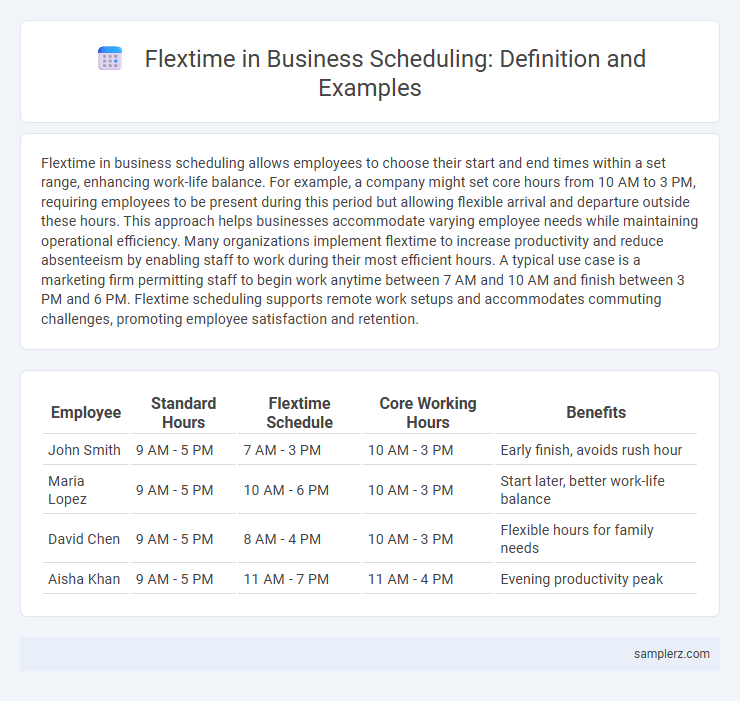Flextime in business scheduling allows employees to choose their start and end times within a set range, enhancing work-life balance. For example, a company might set core hours from 10 AM to 3 PM, requiring employees to be present during this period but allowing flexible arrival and departure outside these hours. This approach helps businesses accommodate varying employee needs while maintaining operational efficiency. Many organizations implement flextime to increase productivity and reduce absenteeism by enabling staff to work during their most efficient hours. A typical use case is a marketing firm permitting staff to begin work anytime between 7 AM and 10 AM and finish between 3 PM and 6 PM. Flextime scheduling supports remote work setups and accommodates commuting challenges, promoting employee satisfaction and retention.
Table of Comparison
| Employee | Standard Hours | Flextime Schedule | Core Working Hours | Benefits |
|---|---|---|---|---|
| John Smith | 9 AM - 5 PM | 7 AM - 3 PM | 10 AM - 3 PM | Early finish, avoids rush hour |
| Maria Lopez | 9 AM - 5 PM | 10 AM - 6 PM | 10 AM - 3 PM | Start later, better work-life balance |
| David Chen | 9 AM - 5 PM | 8 AM - 4 PM | 10 AM - 3 PM | Flexible hours for family needs |
| Aisha Khan | 9 AM - 5 PM | 11 AM - 7 PM | 11 AM - 4 PM | Evening productivity peak |
Introduction to Flextime in Business Scheduling
Flextime in business scheduling allows employees to choose their start and end times within set limits, enhancing work-life balance and productivity. Companies like Google implement flextime to accommodate diverse employee needs while ensuring core business hours are covered. This flexible approach leads to increased job satisfaction and lower absenteeism rates.
Key Features of Flextime Arrangements
Flextime arrangements enable employees to choose their starting and ending work hours within core time periods, promoting work-life balance and increased productivity. Key features include flexible daily schedules, mandatory core hours for team collaboration, and total weekly or monthly hour requirements. This system supports employee autonomy while maintaining organizational efficiency and accountability.
Standard Core Hours with Flexible Start and End Times
Standard core hours typically range from 10 a.m. to 3 p.m., during which all employees are required to be present to ensure team collaboration and meetings. Flexible start and end times allow employees to choose their arrival and departure hours outside the core period, such as starting between 7 a.m. and 10 a.m. and leaving between 3 p.m. and 6 p.m., enhancing work-life balance and productivity. This flextime model supports operational efficiency while accommodating individual scheduling needs.
Compressed Workweeks: Working Longer Days, Fewer Days
Compressed workweeks allow employees to work longer hours each day, typically 10 to 12 hours, in exchange for fewer workdays per week, such as four 10-hour days instead of five 8-hour days. This scheduling flexibility enhances work-life balance by providing extended weekends, which can boost employee satisfaction and productivity. Companies like Amazon and Microsoft have implemented compressed workweeks to reduce operational costs while maintaining high levels of employee engagement.
Job Sharing as a Flextime Approach
Job sharing, a flexible work arrangement, allows two employees to split the hours of one full-time position, enhancing work-life balance and productivity. This flextime approach supports diverse schedules by enabling individuals to work part-time shifts that collectively cover a full-time role. Companies implementing job sharing often see improved employee satisfaction and retention while maintaining operational continuity.
Staggered Shifts to Meet Business Demands
Staggered shifts allow employees to start and end work at different times, optimizing coverage during peak business hours and reducing overcrowding. This scheduling method increases productivity by aligning workforce availability with customer demand fluctuations. Companies implementing staggered shifts report improved employee satisfaction due to flexible start times and enhanced operational efficiency.
Results-Only Work Environments in Scheduling
Results-Only Work Environments (ROWE) prioritize employee output over fixed schedules, allowing workers to choose their hours based on peak productivity times. By implementing flextime, companies enable employees to manage their workdays around personal commitments while maintaining clear performance metrics. This approach increases job satisfaction and drives higher efficiency by focusing on deliverables rather than time spent at the desk.
Split Shifts for Enhanced Work-Life Balance
Split shifts in employee scheduling allow workers to divide their workday into two or more segments, usually separated by a longer break. This approach offers flexibility for managing personal responsibilities such as childcare or education while maintaining productivity during peak business hours. Organizations adopting split shifts often see improved employee satisfaction and reduced absenteeism, contributing to a healthier work-life balance.
Remote and Hybrid Flextime Schedules
Remote and hybrid flextime schedules enable employees to adjust their work hours outside traditional 9-to-5, enhancing productivity and work-life balance. Companies like Microsoft and Salesforce implement hybrid flextime models, allowing staff to split time between home and office with flexible start and end times tailored to individual needs. Data shows that remote flextime reduces absenteeism by 25% and increases employee satisfaction by 30%, supporting long-term workforce retention strategies.
Case Studies: Successful Flextime Implementation in Companies
Google's implementation of flextime allowed employees to tailor work hours around peak productivity, resulting in a 20% increase in overall output and improved job satisfaction. Microsoft adopted a flexible scheduling system that empowered teams to coordinate shifts based on project demands, significantly reducing burnout rates and boosting innovation. At Deloitte, flextime policies enhanced work-life balance, leading to a measurable 15% decrease in employee turnover and higher retention of top talent.

example of flextime in scheduling Infographic
 samplerz.com
samplerz.com